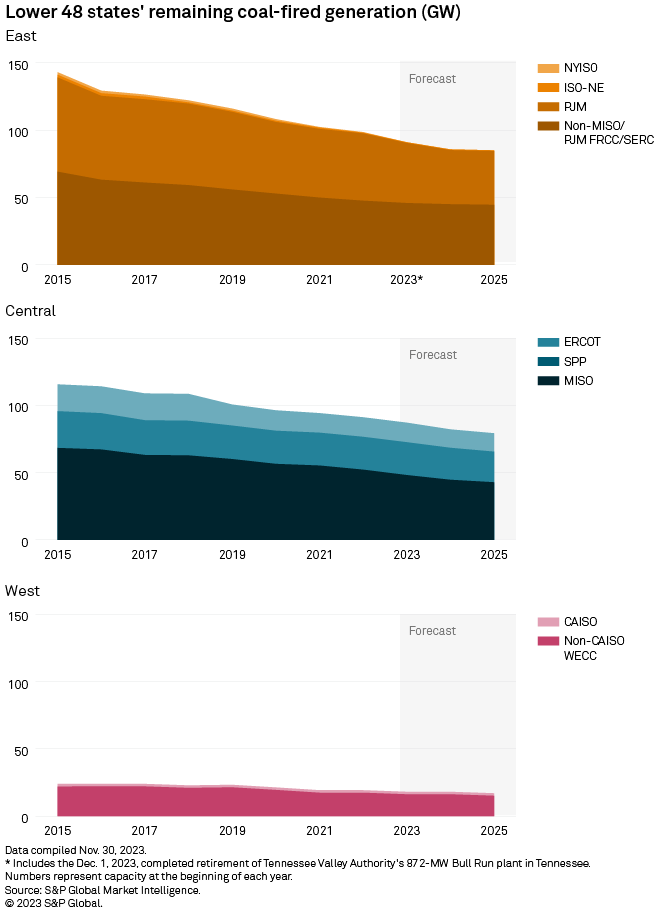The US Environmental Protection Agency on April 24 finalized two rules aimed at tackling air emissions in the power sector, requiring certain fossil-fired generators to cut their carbon emissions by 90% and strengthening regulations on their mercury and air toxic emissions.
The first rule requires all existing coal-fired power plants planning to operate beyond 2039 to capture 90% of their CO2 emissions. New natural gas-fired combined-cycle generators — those set to come online 60 days after the rule's publication — will be subject to the same limit, effectively mandating the installation of carbon capture technology.
The EPA in May 2023 had proposed to limit the carbon emissions of existing gas-fired plants. But after months of warnings from industry players and grid operators that the regulations could lead to power supply shortages, the EPA has decided to address the existing gas fleet in a separate rulemaking to be issued at a later date.
The second rule strengthens the EPA's mercury and air toxics standards, tightening the standard for toxic metals by 67% and reducing the limit for mercury from existing lignite-fired units by 70%.
EPA Administrator Michael Regan is expected to announce the actions at a Howard University event April 25, along with two other new EPA rules on coal ash management and coal plants' wastewater discharges.
The two rules, along with two others regulating coal ash and wastewater, will "allow us to tackle the full array of threats that power plants pose to clean air, safe water and healthy land," Regan told reporters on a call ahead of the announcement. "Finalizing these rules today is a huge step forward in our whole agency's approach to safeguarding public health by mitigating the harmful effects of power plant and industrial air pollution."
Changes from proposal
Existing coal-fired plants and new gas-fired plants will face tougher regulations than the ones the EPA first proposed in May 2023, administration officials said in a call ahead of the announcement.

For instance, the EPA expanded the definition of baseload gas-fired plants — those subject to the highest standards — to those operating above a 40% capacity factor, as opposed to the proposal's cutoff of 50%. The change limits the ability of new gas plants to qualify as peaker plants, which are exempted from the 90% carbon capture requirement.
The final rule also drops hydrogen co-firing as a "best system of emission reduction," or suggested compliance pathway, following skepticism from industry watchers over hydrogen's technical feasibility and climate impact.
And while the proposal would have required all coal-fired plants slated to operate past 2040 to capture 90% of their carbon emissions, the final rule moved that cutoff date forward to 2039. Coal plants slated to retire between 2032 and 2039 are subject to lower CO2 standards, while those slated to retire before 2032 are exempt altogether.
But the EPA also loosened some aspects of the rule, pushing the compliance date for existing coal-fired plants to 2032 from the proposed 2030 deadline. The agency also included two mechanisms intended to ensure grid reliability: one that exempts power plants during designated times of emergency and another that could allow states to delay the retirement of a unit by one year.
The adjustments will "ensure the requirements in these final actions can be implemented without compromising the ability of power companies, grid operators, and state and Federal energy regulators to maintain resource adequacy and grid reliability," the EPA said.
The EPA's updated mercury rule, proposed in April 2023, strengthens the standard by seeking to close the "lignite loophole," which subjects lignite-fired coal plants to weaker mercury limits. Mercury is a powerful neurotoxin that can stunt the brain development of young children and cause other serious health problems for adults.
The EPA said the final rule reflects advances in pollution control technology and is expected to prevent 1,000 pounds of mercury emissions in 2028. The rule is also projected to avoid the release of at least 7 tons of other hazardous air pollutant metals, such as nickel, arsenic and hexavalent chromium during the same year.



